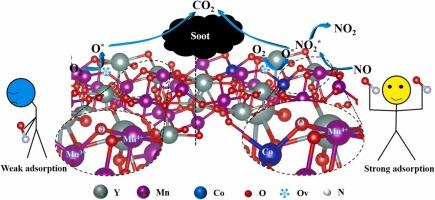Enhanced NOx-assisted soot combustion by cobalt doping to weaken mullite Mn-O bonds for lattice oxygen activation
IF 12.2
1区 环境科学与生态学
Q1 ENGINEERING, ENVIRONMENTAL
引用次数: 0
Abstract
Catalytic combustion is widely regarded as the most efficient technique for removing soot particulates from diesel engine exhaust, with its efficiency largely dependent on the performance of catalysts. In this study, a series of YMn1-xCoxO5-ζ catalysts were synthesized using a hydrothermal method to investigate their catalytic properties in soot oxidation. Among these catalysts, YMCo-0.2 exhibited the highest catalytic activity, achieving 90% soot conversion at 392 °C and demonstrating robust tolerance in the presence of water vapour and SO2. Structural characterisation revealed that Co doping did not alter the fundamental crystal structure of YMn2O5 mullite. Through some characterization comprehensive analysis, and DFT calculations further supported the experimental findings, indicate that Co substitution significantly increased the lattice oxygen mobility and surface active oxygen content. Compared to the surface lattice oxygens at other positions, the weakening of the Mn-O bond results in the lattice oxygens in the Co-O-Mn4+ sites in the catalysts exhibiting higher reactivity. Additionally, the catalyst displayed strong NO and O2 adsorption and activation capabilities, indicating its potential for efficient NOx-assisted soot combustion. This study provides insights for designing and optimizing mullite catalysts for soot combustion.Environmental implications
The catalytic removal of soot particles from diesel exhaust is crucial for protecting both environmental quality and human health. In this work, cobalt (Co) doping into YMn2O5 mullite decreased the strength of Mn-O bond and increased the adsorption capacity of NO, which was beneficial to soot combustion reaction. This research enriches the application of mullite in the field of environmental catalysis.

通过掺钴削弱莫来石 Mn-O 键以激活晶格氧,从而增强氮氧化物辅助燃烧烟尘的效果
催化燃烧被广泛认为是去除柴油发动机尾气中烟尘颗粒的最有效技术,其效率在很大程度上取决于催化剂的性能。本研究采用水热法合成了一系列 YMn1-xCoxO5-ζ 催化剂,以研究它们在烟尘氧化中的催化性能。在这些催化剂中,YMCo-0.2 表现出最高的催化活性,在 392 °C 时可实现 90% 的烟尘转化率,并在水蒸气和二氧化硫存在下表现出强大的耐受性。结构表征显示,掺入 Co 并没有改变 YMn2O5 莫来石的基本晶体结构。通过一些表征综合分析和 DFT 计算进一步支持了实验结果,表明掺入 Co 能显著提高晶格氧迁移率和表面活性氧含量。与其他位置的表面晶格氧相比,Mn-O 键的弱化导致催化剂中 Co-O-Mn4+ 位点的晶格氧表现出更高的反应活性。此外,催化剂还具有很强的 NO 和 O2 吸附和活化能力,这表明催化剂具有高效燃烧 NOx 烟尘的潜力。这项研究为设计和优化用于烟尘燃烧的莫来石催化剂提供了启示。环境意义催化去除柴油机尾气中的烟尘颗粒对保护环境质量和人类健康至关重要。在这项工作中,钴(Co)掺杂到 YMn2O5 莫来石中降低了 Mn-O 键的强度,提高了对 NO 的吸附能力,有利于烟尘燃烧反应。这项研究丰富了莫来石在环境催化领域的应用。
本文章由计算机程序翻译,如有差异,请以英文原文为准。
求助全文
约1分钟内获得全文
求助全文
来源期刊

Journal of Hazardous Materials
工程技术-工程:环境
CiteScore
25.40
自引率
5.90%
发文量
3059
审稿时长
58 days
期刊介绍:
The Journal of Hazardous Materials serves as a global platform for promoting cutting-edge research in the field of Environmental Science and Engineering. Our publication features a wide range of articles, including full-length research papers, review articles, and perspectives, with the aim of enhancing our understanding of the dangers and risks associated with various materials concerning public health and the environment. It is important to note that the term "environmental contaminants" refers specifically to substances that pose hazardous effects through contamination, while excluding those that do not have such impacts on the environment or human health. Moreover, we emphasize the distinction between wastes and hazardous materials in order to provide further clarity on the scope of the journal. We have a keen interest in exploring specific compounds and microbial agents that have adverse effects on the environment.
 求助内容:
求助内容: 应助结果提醒方式:
应助结果提醒方式:


